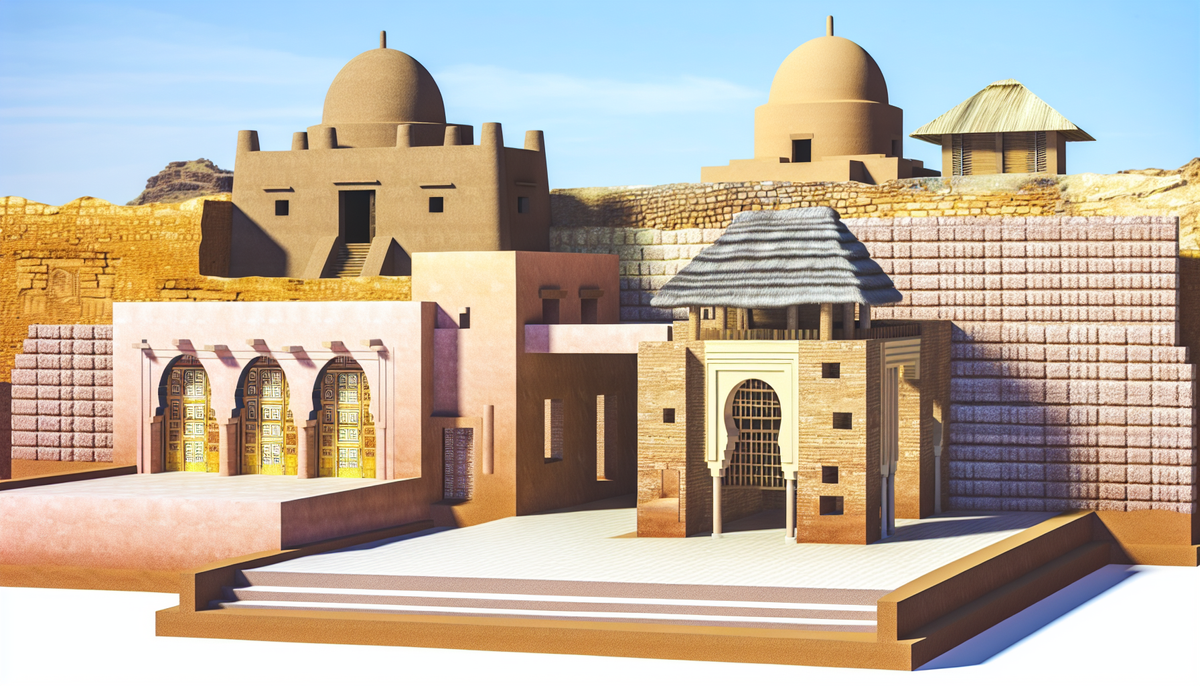Pre-Colonial African Architecture and Its Legacy

Evolution of Indigenous Building Techniques
Indigenous building techniques in Africa have evolved over centuries, shaped by local materials, climatic conditions, and cultural practices. Traditionally, communities utilized natural resources available in their environments—such as mud, clay, straw, timber, and stone—creating structures that harmonized with their surroundings. The use of rammed earth construction, for instance, showcased adaptability to both hot and cold climates, providing thermal comfort while being cost-effective.
Techniques varied widely across regions, reflecting diverse architectural responses to geographical contexts. In the arid regions of the Sahara, the use of compacted earth and stone helped counter the challenges of extreme weather, while in the lush forests of Central Africa, wooden structures with thatched roofs were predominant, allowing for ventilation and moisture control.
Over time, these indigenous methods were influenced by trade, migration, and interactions with other cultures, leading to an amalgamation of styles. For example, the incorporation of Islamic architectural elements into the building traditions of North Africa resulted in unique designs featuring intricate tile work and expansive courtyards. Today, as architects and historians study these indigenous techniques, there is a growing appreciation for their sustainability and relevance in modern architecture, highlighting the importance of preserving this rich heritage.
Influence of Geographical Diversity on Structural Designs
Africa's vast and varied geography has profoundly impacted the structural designs of its indigenous architecture. From the arid deserts to lush rainforests, the physical environment has dictated the materials used and the building techniques employed by different communities. In the Sahara, for example, the presence of sand and stone led to the construction of fortified homes known as kasbahs, which were designed to withstand harsh winds and extreme temperatures. These structures often feature thick walls and small windows to minimize heat exposure.
Conversely, in the humid environments of Central and West Africa, building practices adapted to heavy rainfall. Here, timber framed constructions with thatched roofs became prevalent, allowing for effective drainage while providing ventilation. Communities in these regions also embraced elevated platforms to protect homes from flooding and pests.
Additionally, coastal areas utilized local resources like coral and palm fronds, leading to distinct architectural styles that reflected both availability of materials and the necessity for resilience against constant coastal wear. Overall, Africa's geographical diversity not only influenced the physical aspects of architecture but also fostered a rich tapestry of cultural expressions that continue to inform modern design while celebrating indigenous wisdom and practices.
Materials and Tools Used in Traditional Construction
Traditional African architecture is characterized by a diverse array of materials and tools that are deeply rooted in local environments and cultural practices. The choice of materials typically reflects the immediate availability and adaptability to climatic conditions. Mud and clay are among the most widely used materials, forming the basis for many structures, such as the iconic adobe houses of the Sahel region. This natural resource not only provides thermal insulation but also creates a harmonious relationship with the landscape.
In forested regions, timber becomes a vital resource, utilized for framing, flooring, and roofing. Indigenous communities often employed techniques such as timber framing and thatching with palm leaves to create durable homes that blend with the environment. Stone, used in areas with easy access to quarries, enabled the construction of robust structures that have stood the test of time, such as the Great Zimbabwe ruins.
Accompanying these materials, traditional tools played a crucial role in construction. Handcrafted implements like hoes, axes, and chisels, often made from local materials, allowed artisans to shape and assemble their buildings effectively. These age-old practices reveal not only the ingenuity of indigenous builders but also their deep understanding of the materials and techniques that resonate with their cultural identity and environmental surroundings.
Socio-Cultural Impacts on Architectural Styles
Architectural styles in pre-colonial Africa were profoundly influenced by the socio-cultural dynamics of various communities. Buildings were not merely functional structures; they served as vital expressions of identity, spirituality, and social organization. Each region's design reflected the prevailing cultural beliefs and traditions, often symbolizing the community's values.
For instance, in communities where spirituality dominated, architecture often included sacred spaces such as shrines and altars, meticulously integrated into the landscape. The circular huts found in many societies were designed not just for utility but to represent communal living and unity, with spaces allocated for family and communal gatherings at their core.
Moreover, social hierarchies significantly shaped architectural forms. Chiefs and leaders often lived in larger, more elaborate homes, signifying their status and authority. The designs of these structures included intricate decorations, embodying the community's artistic values and heritage.
Trade routes further influenced architectural styles as different cultures exchanged ideas and materials. This interaction led to the incorporation of diverse elements, creating hybrid designs that reflected the coexistence of multiple cultural identities. Consequently, the architecture of pre-colonial Africa is a rich tapestry, echoing the complexities of social structures, traditions, and interactions that defined the continent's diverse cultures.
Exemplary Ancient Architectural Sites and their Significance
Throughout Africa, numerous ancient architectural sites stand as testaments to the ingenuity and cultural richness of its civilizations. One such site is Great Zimbabwe, located in present-day Zimbabwe. This remarkable stone city, built between the 11th and 15th centuries, showcases advanced dry-stone construction techniques and served as the political and economic hub of the Kingdom of Zimbabwe. Its iconic conical towers symbolize the power and sophistication of its people, highlighting the region's historical significance in trade networks across the continent.
In West Africa, the ancient city of Timbuktu remains a beacon of architectural brilliance. Renowned for its mud-brick mosques and the famous University of Sankoré, it was a center of Islamic scholarship and culture during the 14th century. The architectural style embodies the fusion of Islamic influences and indigenous techniques, marking it as a crucial site for understanding cultural exchanges in the Sahel region.
Another exemplary site is the rock-hewn churches of Lalibela in Ethiopia, built in the 12th century. These extraordinary structures, carved out of solid rock, reflect the deep religious devotion of their creators while showcasing an exceptional understanding of engineering. Collectively, these sites illustrate Africa's rich architectural heritage and the enduring legacy of its diverse cultures.
Preservation of Architectural Heritage in the Modern Era
The preservation of Africa's architectural heritage in the modern era faces significant challenges and opportunities. As globalization and urbanization accelerate, the risk of losing traditional building techniques and historical sites increases. However, there is a growing recognition of the importance of safeguarding these cultural treasures, leading to various preservation initiatives across the continent.
Many African nations have established heritage conservation policies aimed at protecting iconic structures and sites. UNESCO's World Heritage designation, for example, has been instrumental in drawing international attention and support for the preservation of sites like the Great Pyramids of Giza and the rock-hewn churches of Lalibela. Such recognition not only promotes tourism but also fosters community pride and awareness regarding the importance of maintaining cultural identity.
Additionally, grassroots movements have emerged, with local communities actively engaging in the documentation and restoration of their architectural heritage. Workshops and educational programs are being conducted to teach traditional building techniques to younger generations, ensuring that skills are passed down and adapted to contemporary contexts.
Despite the pressures of modern development, these efforts reflect a vital commitment to preserving Africa's rich architectural legacy, highlighting the intrinsic value of these structures as vital links to the past and sources of cultural identity for future generations.
Contribution of Indigenous Architecture to Global Knowledge
Indigenous architecture in Africa has made significant contributions to global knowledge, offering unique insights into sustainable building practices, cultural resilience, and environmental adaptation. The architectural wisdom of Africa's diverse communities emphasizes harmony with nature, utilizing locally-sourced materials and techniques that have been passed down through generations. This approach not only minimizes environmental impact but also fosters a deeper understanding of ecological balance and resource management.
One prominent example is the use of earthen materials in building construction, such as adobe and rammed earth, which have been proven effective in regulating indoor climates, reducing energy consumption, and enhancing thermal efficiency. These techniques are gaining recognition globally, as contemporary architects and builders seek eco-friendly solutions to modern construction challenges.
Moreover, indigenous architectural styles reflect rich cultural narratives, expressing local values and identities. The adaptation of design to meet the specific needs of communities demonstrates innovative problem-solving that can inform global architectural discourse, particularly in addressing social and climatic challenges.
The global architectural community increasingly acknowledges the relevance of indigenous knowledge in creating resilient, sustainable environments. Collaboration with indigenous architects and builders encourages the exchange of ideas and practices, enriching contemporary architecture and fostering respect for cultural diversity in the built environment. This synergy ultimately leads to a more inclusive and sustainable future for architecture worldwide.



